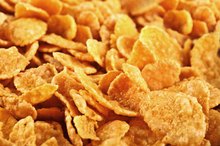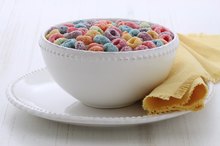Three Places Where Carbs Are Stored in Body
Carbohydrates are your body’s most efficient fuel source, and it is the only source of fuel for certain vital tissues such as your brain and blood cells. Therefore, your body has ways of storing the carbs you eat for future use. These carb stores are particularly critical for situations in which your body does not have a quick supply of simple sugars -- such as after an overnight fast — or if you are burning fuel at a high rate, such as during high-intensity exercise. Your body stores carbs in the form of glycogen in your liver and muscles. Additionally, your body converts excess carbs to be stored in fat tissue.
Digestion and Absorption of Carbohydrates
Your diet consists of simple and complex carbohydrates. Simple carbs, such as those in white table sugar, consist of one or two sugar molecules, whereas the complex carbs found in whole grains and potatoes have up to one million sugar molecules. Enzymes secreted in your saliva break the complex carbs down into simple two-sugar carb molecules in your mouth. Your pancreas and small intestine also secrete enzymes to further break the two-sugar carbs into single-sugar carbs. Cells in your small intestine absorb these sugars into the bloodstream, where they travel to your muscles, liver, brain and other body tissues to provide efficient fuel for cell function. The sugars not immediately needed are stored for later use.
- Your diet consists of simple and complex carbohydrates.
- Enzymes secreted in your saliva break the complex carbs down into simple two-sugar carb molecules in your mouth.
Liver Glycogen
Explain Why Carbohydrates Are Said to Spare Proteins
Learn More
Glycogen stored in your liver primarily serves to maintain your blood sugar levels during an overnight fast. Changes in blood sugar levels activate or deactivate certain hormones such as insulin, glucagon and epinephrine to signal enzymes to stimulate glycogen synthesis or breakdown, depending on your fuel status. For example, a low blood sugar level from fasting overnight results in high glucagon, low insulin and high epinephrine to increase glycogen breakdown to maintain blood glucose and provide tissues with fuel. Alternatively, high blood glucose from a high-carb meal increases insulin, which activates glycogen synthesis and storage enzymes.
- Glycogen stored in your liver primarily serves to maintain your blood sugar levels during an overnight fast.
- Alternatively, high blood glucose from a high-carb meal increases insulin, which activates glycogen synthesis and storage enzymes.
Muscle Glycogen
The majority of the total amount of glycogen in your body exists in your muscle. Unlike liver glycogen, muscle glycogen breakdown does not increase specifically due to whether you are fasted. Instead, muscle glycogen breakdown increases in response to your muscles’ demand for ATP, or adenosine triphosphate, for cellular energy. The demand is particularly high during high-intensity exercise such as sprinting or weightlifting, which can only use carbs for fuel. However, elevated insulin levels from a high-carb meal will increase glucose uptake into muscle, which will increase ATP synthesis, reduce muscle cell energy demand and enable glycogen synthesis enzymes to form glycogen.
- The majority of the total amount of glycogen in your body exists in your muscle.
- Instead, muscle glycogen breakdown increases in response to your muscles’ demand for ATP, or adenosine triphosphate, for cellular energy.
Carbs Stored In Fat Tissue
When Does the Body Start to Use Muscle Tissue for Energy?
Learn More
Additionally, certain intermediate molecules in carb metabolism can be converted to fat and stored in fat tissue. After you absorb single-sugar carbs into the bloodstream, your tissues must further break down the sugar into ATP, a form of energy your cells can use. This process involves multiple enzymatic reactions in the mitochondria. Depending on how much energy you need, some of the intermediate molecules of this process might be transported out and converted to triglycerides in your fat tissue. If your energy demands are low and sugar supply is high — for example, if you are watching TV and eating several candy bars — the extra sugars might begin to go through the breakdown process, but will eventually be transported out and stored as fat tissue.
- Additionally, certain intermediate molecules in carb metabolism can be converted to fat and stored in fat tissue.
- Depending on how much energy you need, some of the intermediate molecules of this process might be transported out and converted to triglycerides in your fat tissue.
Related Articles
References
- "Marks' Basic Medical Biochemistry: A Clinical Approach (third edition)"; Michael Lieberman et al.; 2009
- "Advanced Nutrition and Human Metabolism (fourth edition)"; Sareen Gropper et al.; 2005
- D'anci KE, Watts KL, Kanarek RB, Taylor HA. Low-carbohydrate weight-loss diets. Effects on cognition and mood. Appetite. 2009;52(1):96-103. doi:10.1016/j.appet.2008.08.009
- Adeva-Andany M, Gonzalez-Lucan M, Donapetry-Garcia C. et al. Glycogen metabolism in humans. BBA Clinical. 2016;5:85-100. doi:10.1016/j.bbacli.2016.02.001
- Zajac A, Poprzecki S, Maszycyk A, et al. The effects of a ketogenic diet on exercise metabolism and physical performance in off-road cyclists. Nutrients. 2014;6(7):2493-508. doi:10.3390/nu6072493
Writer Bio
Gina Battaglia has written professionally since 2006. She served as an assistant editor for the "International Journal of Sports Medicine" and coauthored a paper published in the "Journal of Strength and Conditioning Research." Battaglia completed a Doctor of Philosophy in bioenergetics and exercise science at East Carolina University and a Master of Science in biokinesiology from the University of Southern California.







